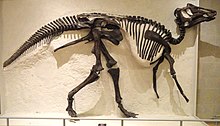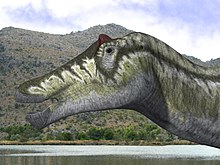Prosaurolophus
| Prosaurolophus | |
|---|---|

| |
| P. maximus specimen collected 1921, Royal Ontario Museum | |
| Scientific classification | |
| Domain: | Eukaryota |
| Kingdom: | Animalia |
| Phylum: | Chordata |
| Clade: | Dinosauria |
| Clade: | †Ornithischia |
| Clade: | †Ornithopoda |
| Family: | †Hadrosauridae |
| Subfamily: | †Saurolophinae |
| Genus: | †Prosaurolophus Brown, 1916 |
| Species: | †P. maximus
|
| Binomial name | |
| †Prosaurolophus maximus Brown, 1916
| |
| Synonyms[1][2][3] | |
| |
Prosaurolophus (
The type species is P. maximus, described by American paleontologist Barnum Brown of the American Museum of Natural History in 1916. A second species, P. blackfeetensis, was described by Jack Horner of the Museum of the Rockies in 1992. The two species were differentiated mainly by crest size and skull proportions.
History of discovery
Well-known
The second species, P. blackfeetensis, is based on a specimen in the Museum of the Rockies (MOR 454), which was described by another notable paleontologist, Jack Horner. This specimen, and the remains of three or four other individuals, were found in Glacier County, Montana.[8] In this case, the fossils were found in a bonebed of Prosaurolophus remains, which indicates that the animals lived together for at least some time. The bonebed is interpreted as reflecting a group of animals that congregated near a water source during a drought.[9]
Horner differentiated the two species by details of the crest. He interpreted P. blackfeetensis as having a steeper, taller face than P. maximus, with the crest migrating backward toward the eyes during growth.[8] More recent studies have regarded the differences as insufficient to support two species.[1][2][3]
Description

Prosaurolophus was a large-headed duckbill; the most complete described specimen has a skull around 0.9 metres (3.0 ft) long with its body size measuring 8.5 metres (28 ft) in length and 3 metric tons (3.3 short tons) in body mass.[10][11] It had a small, stout, triangular crest in front of the eyes; the sides of this crest were concave, forming depressions.[12] This crest grew isometrically (i.e. without changing in proportion) throughout the lifetime of the individual, leading to speculation that the species may have had a soft tissue display structure, such inflatable nasal sacs.[13]
When originally described by Brown, Prosaurolophus maximus was known from a skull and jaw. Half of the skull was badly weathered at the time of examination, and the level of the
Patches of preserved skin are known from two juvenile specimens,
Classification
Because of its name, Prosaurolophus is often associated with Saurolophus. However, this is contentious; some authors have found the animals to be closely related,[15][16][17] whereas others have not, instead finding it closer to Brachylophosaurus, Edmontosaurus, Gryposaurus, and Maiasaura.[7]
History of classification

In 1918,
In 1954, Charles Sternberg reevaluated the genera in Hadrosauridae, invoking the probability that Saurolophinae should be sunk into Hadrosaurinae. This greatly changed the classifications of the family, as the "saurolophines" were kept separate because of their supposedly "footed" ischium. Sternberg identified that the "footed" ischium assigned to Saurolophus was not found with the holotype, and was only assigned to it because of the location of the find. Also, he noted that William Parks (1924) found a complete skeleton of Prosaurolophus clearly showing an "unfooted" ischium, which Sternberg realized meant that it was unlikely that Saurolophus possessed a "footed" ischium. Sternberg's reevaluation led to the abandonment of Saurolophinae.[3]
Young (1958) found that the subfamily Saurolophinae, however, was not to be abandoned, and in it placed his new genus Tsintaosaurus, as well as Prosaurolophus and Saurolophus, and also Kritosaurus (which included Gryposaurus and excluded K. navajovius). Two years previous, Friedrich von Huene separated Saurolophinae from Hadrosauridae, naming Saurolophidae. Saurolophidae was a family in Huene's Hadrosauria, including the genera Prosaurolophus, Saurolophus, and the probably unrelated Bactrosaurus. Another author to support the separation of Saurolophinae was John Ostrom (1961). Ostrom found that the saurolophines Brachylophosaurus, Prosaurolophus, and Saurolophus all possessed a "pseudonarial crest", a feature which united them, while distinguishing them from hollow-crested lambeosaurines.[3]
Hopson (1975) supported the division of Hadrosauridae into two subfamilies, Hadrosaurinae and Lambeosaurinae, and was first to suspect what modern analyses find. Hopson found that Hadrosaurinae could clearly be divided into groups, the "kritosaurs", the "edmontosaurs", and the "saurolophines", including Prosaurolophus, Saurolophus, Tsintaosaurus and Lophorhothon, and intermediate between the "kritosaurs" and "saurolophines". Brett-Surman (1975) also followed Sternberg with sinking Saurolophinae into Hadrosaurinae, and like Hopson, he recognized three groups within the subfamily. Like Hopson, one group was called the Edmontosaurus lineage, the second the Kritosaurus group, and the third uniting Prosaurolophus and Saurolophus. Over a decade later in 1989, Brett-Surman scientifically named the groups of hadrosaurines, the first becoming Edmontosaurini, the second Kritosaurini, and the third Saurolophini.[3]
Phylogeny
The first cladistic analysis to encompass the interrelationships of Hadrosauridae was conducted by Weishampel and Horner (1990). They found Saurolophinae synonymous with Hadrosaurinae, but only separated the subfamily into two groups. The first group included Gryposaurus, Aralosaurus, Maiasaura, and Brachylophosaurus. The other contained Edmontosaurus, Saurolophus, Prosaurolophus, Lophorhothon, and Shantungosaurus.[3]
A detailed cladgram of hadrosaurid relationships was published in 2013 by Acta Palaeontologica Polonica. The study was led by Alberto Prieto-Márquez, and recovered Prosaurolophus in a similar position as suggested by Brown in 1916. The below cladogram was the one recovered by their analysis:[17]
| Saurolophinae |
| ||||||||||||||||||||||||||||||||||||||||||||||||||||||||||||||||||||||||||||||||||||||||||||||||||||||||||||

In 2001, Prosaurolophus was studied with other hadrosaurids by Wagner. The genus, along with Corythosaurus and Maiasaura, were considered by Wagner to be synonymous with Saurolophus, Hypacrosaurus and Brachylophosaurus respectively. Prosaurolophus maximus was reassigned to Saurolophus as S. maximus. The same year however, Prosaurolophus was found to be distinct from Saurolophus, in an analysis of Hu et al.. Their analysis was unique from any of the time, and they recovered Prosaurolophus in Saurolophinae, with Saurolophus, Lophorhothon, Tsintaosaurus, Jaxartosaurus, and Kritosaurus. No other analysis has recovered this group of dinosaurs.[3]
Horner et al. (2004) also recovered a different phylogeny of Saurolophinae. Prosaurolophus was, for the first time, recovered separate from Saurolophus, in fact not even closely related. Prosaurolophus was found in a group with Brachylophosaurus, Maiasaura, Grpyosaurus, and Edmontosaurus, while Saurolophus was grouped with Naashoibitosaurus (=Kritosaurus) and "Kritosaurus" australis.[3]
The Prosaurolophus-Saurolophus clade has been a problematic grouping when trying to place among hadrosaurines. Many skull features are similar to Edmontosaurus, while other are closer to Gryposaurus, so the group has been classified as close to both. However, the clade might be closer to Edmontosaurus, as the features are more numerous uniting them.[3]
Paleobiology

As a hadrosaurid, Prosaurolophus would have been a large
Social behavior
As noted, there is bonebed evidence that this genus lived in groups during at least part of the year.[9] Additionally, it had several potential methods for display in a social setting. The bony facial crest is an obvious candidate, and nasal diverticula may also have been present. These postulated diverticula would have taken the form of inflatable soft-tissue sacs housed in the deep excavations flanking the crest and elongate holes for the nostrils. Such sacs could be used for both visual and auditory signals.[19]
Paleoecology

The Dinosaur Park Formation, home to Prosaurolophus maximus, is interpreted as a low-relief setting of
The roughly contemporaneous Two Medicine Formation, home to P. maximus,
Diet
Prosaurolophus maximus itself lived in coastal floodplains and dined on conifer trees, implying that it was more likely a browser rather than a grazer.[23][24]
See also
References
- ^ .
- ^ PMID 22876302.
- ^ a b c d e f g h i j Prieto-Marquez, A. (2008). "Phylogeny and Historical Biogeography of Hadrosaurid Dinosaurs". Electronic Theses, Treatises and Dissertations. 460. Archived from the original on 2014-07-15. Retrieved 2014-06-12.
- ^ a b Brown, Barnum (1916). "A new crested trachodont dinosaur, Prosaurolophus maximus" (PDF). Bulletin of the American Museum of Natural History. 35 (37): 701–708. Retrieved 2007-04-15.[permanent dead link]
- ^ Lull, Richard Swann; Wright, Nelda E. (1942). Hadrosaurian Dinosaurs of North America. Geological Society of America Special Paper 40. Geological Society of America. p. late 22.
- ^ Parks, William A (1924). "Dyoplosaurus acutosquameus, a new genus and species of armoured dinosaur; and notes on a skeleton of Prosaurolophus maximus". University of Toronto Studies, Geological Series. 18: 1–35.
- ^ ISBN 978-0-520-24209-8.
- ^ a b Horner, John R. (1992). "Cranial morphology of Prosaurolophus (Ornithischia: Hadrosauridae) with descriptions of two new hadrosaurid species and an evaluation of hadrosaurid phylogenetic relationships". Museum of the Rockies Occasional Paper. 2: 1–119.
- ^ JSTOR 3514834.
- ^ Lull, Richard Swann; Wright, Nelda E. (1942). Hadrosaurian Dinosaurs of North America. Geological Society of America Special Paper 40. Geological Society of America. p. 226.
- OCLC 985402380.
- ^ Lull, Richard Swann; Wright, Nelda E. (1942). Hadrosaurian Dinosaurs of North America. Geological Society of America Special Paper 40. Geological Society of America. pp. 172–175.
- ^ S2CID 109440173.
- ^ PMID 22319623.
- ISBN 978-0-520-06727-1.
- .
- ^ .
- S2CID 33253407.
- S2CID 88689241.
- ^ Eberth, David A. 2005. "The geology", in Dinosaur Provincial Park, pp. 54–82.
- ^ Braman, Dennis R., and Koppelhus, Eva B. 2005. "Campanian palynomorphs", in Dinosaur Provincial Park, pp. 101–130.
- ^ a b Weishampel, David B.; Barrett, Paul M.; Coria, Rodolfo A.; Le Loeuff, Jean; Xu Xing; Zhao Xijin; Sahni, Ashok; Gomani, Elizabeth, M.P.; and Noto, Christopher R. (2004). "Dinosaur Distribution", in The Dinosauria (2nd), pp. 517–606.
- ^ Pickrell, John (29 November 2019). "'Remarkable' fossil features an insect trapped in amber, stuck to a dinosaur jaw". ScienceMag.org. AAAS. Retrieved 15 August 2020.
- PMID 31784622.
